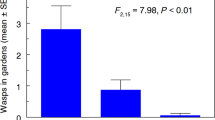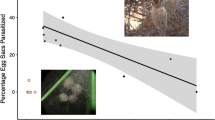Abstract
Mortality factors were determined in over 20000 pupal skins of Brassolis sophorae and Opsiphanes invirae, collected from 55 sites in the urban area of Campinas, São Paulo, southeast Brazil. Almost 50% of B. sophorae pupae and 30% of O. invirae pupae were killed by various identifiable factors, which may have an appreciable influence in determining adult population size. Mortality was related to type of attachment site, distance from the center of the city, area occupied by buildings and houses, vegetation cover, and other urban variables. Exposed pupation sites such as outside walls had a lower frequency of successful eclosions than darker or more sheltered sites, such as offset skirting boards, garages, or mailboxes, which act as partial refuges against parasitoids. Mortality levels were higher in regions of the city with high vegetation cover. Vegetation cover and distance from the city center were the best predictors of parasitism level of B. sophorae by the chalcidid wasp Spilochalcis morleyi. The viability of S. morleyi (data from parasitized B. sophorae) did not differ significantly among different regions of the city. These data do not support an exclusive model of “escape from parasites” (or other natural enemies) for explaining the abundance of urban butterflies.
Similar content being viewed by others
References
Bastian RA, Hart ER (1990) First-generation parasitism of the Mimosa webworm (Lepidoptera: Plutellidae) by Elasmus albizziae (Hymenoptera: Eulophidae) in an urban forest. Environ Entomol 19:409–414
Brown KS Jr (1992) Borboletas da Serra do Japi: diversidade, habitats, recursos alimentares e variação temporal. In: Morellato LPC (ed) História natural da Serra do Japi: ecologia e preservação de uma área florestal no Sudeste do Brasil. Editora da UNICAMP, Campinas, São Paulo
DeVries PJ (1987) The butterflies of Costa Rica and their natural history: Papilionidae, Pieridae and Nymphalidae. Princeton University Press, Princeton
Edwards RL (1955) How the hymenopteran parasite Mormoniella vitripennis (Walker) finds its host. Br J Anim Behav 3:37–38
Gonzaga L, Lordello E (1952) Sobre os inimigos naturais da Lagarta das Palmeiras Brassolis sophorae sophorae (L.) (Lep., Brassolidae). An Esc Sup Agric “L. Queiroz” 9:23–30
Hassell MP (1982) Patterns of parasitism by insect parasitoids in patchy environments. Ecol Entomol 7:365–377
Itô Y, Miyashita K (1968) Biology of Hyphantria cunea Drury (Lepidoptera: Arctiidae) in Japan. V. Preliminary life tables and mortality data in urban areas. Res Popul Ecol 10:177–209
Klausnitzer B, Richter K (1983) Presence of an urban gradient demonstrated for carabid associations. Oecologia 59:79–82
Miller FD Jr, Hart ER (1987) Overwintering survivorship of pupae of the Mimosa webworm, Homadaula anisocentra (Lepidoptera: Plutellidae), in an urban landscape. Ecol Entomol 12:41–50
Nie NH, Hull CH, Jenkins JG, Steinbrenner K, Bent DH (eds) (1975) Statistical package for the social sciences. McGraw-Hill, New York
Orphanides GM, Gonzales D (1970) Effects of adhesive materials and host location on parasitization by uniparental race of Trichogramma pretiosum. J Econ Entomol 63:1891–1898
Ruszczyk A (1986) Mortality of Papilio scamander scamander (Lep., Papilionidae) pupae in four districts of Porto Alegre (S. Brazil) and the causes of superabundance of some butterflies in urban areas. Rev Brasil Biol 46:567–579
Ruszczyk A (1987) Distribution and abundance of butterflies in the urbanization zones of Porto Alegre, Brazil. J Res Lepid 25:157–178
Ruszczyk A, Araujo AM (1992) Gradients in butterfly species diversity in an urban area in Brazil. J Lepid Soc46:255–264
Ruszczyk A, Carvalho MC (1993) Malfunction of ecdysis and female biased mortality in urban Brassolis sophorae (Nymphalidae: Brassolinae). J Lepid Soc 47:134–139
Sternburg JG, Waldbauer GP, Scarbrough AG (1981) Distribution of Cecropia moth (Saturniidae) in central Illinois: a study in urban ecology. J Lepid Soc 35:304–320
Waldbauer GP, Sternburg JG (1967) Differential predation on cocoons of Hyalophora cecropia (Lepidoptera: Saturniidae) spun on shrubs and trees. Ecology 48:312–315
Waldbauer GP, Sternburg JG, George WG, Scarbrough AG (1970) Hariy and downy woodpecker attacks on cocoons of urban Hyalophora cecropia and other saturniids (Lepidoptera). Ann Entomol Soc Am 63:1366–1369
Young AM, Muyshondt A (1975) Studies on the natural history of Central American butterflies in the family cluster Satyridae-Brassolidae-Morphidae (Lepidoptera: Nymphaloidea) III. Opsiphanes tamarindi and Opsiphanes cassina in Costa Rica and El Salvador. Stud Neotrop Fauna 10:19–56
Author information
Authors and Affiliations
Rights and permissions
About this article
Cite this article
Ruszczyk, A. Spatial patterns in pupal mortality in urban palm caterpillars. Oecologia 107, 356–363 (1996). https://doi.org/10.1007/BF00328452
Received:
Accepted:
Issue Date:
DOI: https://doi.org/10.1007/BF00328452




